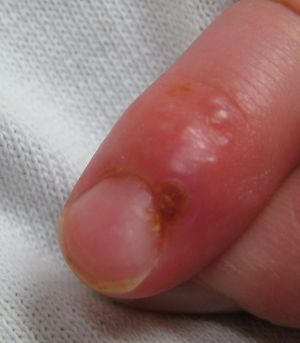We need you! Join our contributor community and become a WikEM editor through our open and transparent promotion process.
Herpetic whitlow
From WikEM
Contents
Background
- HSV infection of distal finger[1]
- Usually occurs from contact with oral herpes, or autoinoculation from genital herpes
- Incubation period of 2-20 days, with possible prodrome of fever or malaise
- 60% due to HSV-1, 40% due to HSV-2
Clinical Features
- Same burning, pruritic sensation as from other herpes infections
- Vesicular ullae
- Finger may be indurated and tender (but should not be tense, as in a felon)
- Rash develops over 7-10 days, with possible ulceration and rupture
- Symptoms improve, crust over, and heal after 10-14 days with viral shedding terminating at this point
- Complete resolution by 15-21 days
Differential Diagnosis
Hand and finger infections
- Bedbugs
- Closed fist infection (Fight Bite)
- Hand cellulitis
- Hand deep space infection
- Herpetic whitlow
- Felon
- Flexor tenosynovitis
- Paronychia
- Scabies
- Sporotrichosis
Herpes Simplex Virus-1
- Herpes gingivostomatitis
- Herpetic whitlow
- Herpes labialis (cold sore)
- Herpes keratitis
- Eczema herpeticum
Evaluation
- Clinical diagnosis, based on history and physical exam
- Available laboratory studies (not required for diagnosis)[2]:
- Viral culture (gold standard)
- Direct immunofluorescence
- Tzanck smear (poor specificity)
Management
- Immobilization, elevation, analgesia
Anitivirals
Ativirals such as Acyclovir or Valacyclovir may shorten duration of infection[3]
- Topical acyclovir 5% shortens duration and viral shedding in primary infection[3]
- Oral acyclovir dosing - 800mg BID initiated during prodrome may prevent recurrence
Secondary Prevention
- Application of clean dressings to involved digits is important to prevent autoinoculation or spread to other individuals
Disposition
- Outpatient managment
See Also
References
- ↑ Wu IB, Schwartz RA. Herpetic whitlow. Cutis. Mar 2007;79(3):193-6
- ↑ Mohan RPS, Verma S, Singh U, Agarwal N. Acute primary herpetic gingivostomatitis. BMJ Case Reports. 2013;2013:bcr2013200074. doi:10.1136/bcr-2013-200074.
- ↑ 3.0 3.1 Nikkels AF, Pierard GE. Treatment of mucocutaneous presentations of herpes simplex virus infections. Am J Clin Dermatol. 2002;3(7):475-87.
Authors
Kevin Lu, Jordan Swartz, Ross Donaldson, Daniel Ostermayer, Neil Young


